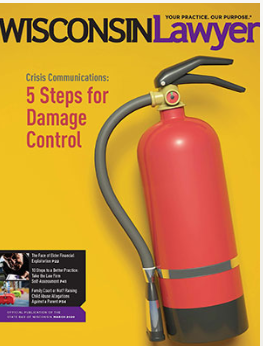


Crisis Communication: 5 Steps for Damage Control
By Thom Fladung, Hennes Communications, writing for The Wisconsin Lawyer:
Attorney Andy Phillips, like many folks, looks back a bit wistfully at the “good old days.”
“I wish it was back in the day where I could go home at 6 o’clock and sit down with the paper for a half hour,” says Phillips, whose practice at von Briesen & Roper, Milwaukee, includes government and school clients – people often in the public spotlight. “But that’s just not the way society works anymore. I wish I could go home at 6 o’clock and not have my phone ring all through the night or get emails through the night. It doesn’t work that way either.”
How journalism and communications work today has undergone dramatic change in the past decade or so, with profound implications for anyone caught up in a news story, especially lawyers and their clients.
The rise of iterative journalism, the dominance of social media, and the sheer speed of modern communications have placed an even greater premium on understanding and practicing the fundamentals of effective crisis communications.
“It used to be you could control the story for a day and really form a message before it got out there,” Phillips says. “But now everything is so instantaneous and oftentimes you’re reacting. It’s difficult to be thoughtfully proactive.”
5 Rules for Damage Control
How can a person plan to be thoughtfully proactive? At Hennes Communications, we tell every client about what we call the “damage control playbook” and its five simple rules:
1) Tell the truth. Even if you don’t believe doing so is the morally correct approach, it’s the pragmatically correct approach. If you don’t tell the truth, you’ll lose credibility, making all communications that follow suspect. And the truth will come out. If you haven’t told the truth, you’ll now be accused of a cover-up. Remember, often damage from the cover-up exceeds the damage from the actual misstep.
2) Tell it first. If you don’t, someone else will – and then you’ll have lost control of your message. We frequently advise clients who know bad news is going to break to break the news themselves. Then, the story won’t be an “exclusive” broken by a reporter or revealed by a whistleblower or posted by a Facebook user. It’s your story. Tell it yourself.
3) Tell it all – or tell as much of it as you can. There are legal and legitimate reasons for withholding some detail. Privacy issues must be considered. The Health Insurance Portability and Accountability Act (HIPAA) and the Family Educational Rights and Privacy Act (FERPA) may come into play. You might not know many of the details at the outset of a crisis. But you can count on the fact that details inevitably emerge. You know the context, history, and background behind your crisis. The more you can tell of your story, the more you’ll control it.
For the rest, click here.